GREAT-TAILED GRACKLE MYSTERIES
a photo discussion by D. Roberson
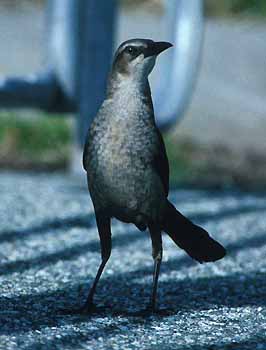 At this very moment in late June 1999, the first Great-tailed Grackles
to nest in Monterey County (coastal central California) are feeding fledglings.
Yet the two females stuffing food down gaping throats look quite unlike
the female shown in the photo to the left. This female, an apparent first-summer
(SY="second calendar year" in banding lingo) Great-tailed Grackle, appeared
at Pt. Sur, Monterey County, on 29 May 1997. In fact, it was one of the
first females ever in Monterey County (the first male was in 1994). She
has already been featured
on Joe Morlan's web site with reference to the retained dark eyes at
this late date (nearly a year-old individual). More generally, Joe wrote
that the Great-tailed Grackle "exhibits a considerable amount of geographic
variation and is a relatively recent invader to California. Most California
birds are thought to be derived from the smaller Q. m. nelsoni,
but the larger Q. m. monsoni also apparently occurs. I suspect these
two forms probably intergrade here thus accounting for the high degree
of variability of California birds. I think subspecific identification
is unwise without measurements and examination in the hand."
At this very moment in late June 1999, the first Great-tailed Grackles
to nest in Monterey County (coastal central California) are feeding fledglings.
Yet the two females stuffing food down gaping throats look quite unlike
the female shown in the photo to the left. This female, an apparent first-summer
(SY="second calendar year" in banding lingo) Great-tailed Grackle, appeared
at Pt. Sur, Monterey County, on 29 May 1997. In fact, it was one of the
first females ever in Monterey County (the first male was in 1994). She
has already been featured
on Joe Morlan's web site with reference to the retained dark eyes at
this late date (nearly a year-old individual). More generally, Joe wrote
that the Great-tailed Grackle "exhibits a considerable amount of geographic
variation and is a relatively recent invader to California. Most California
birds are thought to be derived from the smaller Q. m. nelsoni,
but the larger Q. m. monsoni also apparently occurs. I suspect these
two forms probably intergrade here thus accounting for the high degree
of variability of California birds. I think subspecific identification
is unwise without measurements and examination in the hand."
I want to focus on the variation noted in Monterey County birds, using
some comparative photos from here and elsewhere. On the bird to the left,
note the very hefty bill, the long legs, the cold grayish tone to the upperparts,
and the extensively whitish-mottled color to the underparts. Note also
the prominent supercilium set off against a dark cap, the white throat
and malar region, and the thin blackish sub-malar and super-malar stripes.
Then compare this 1997 female with one of two females which nested at Roberts
Lake, Seaside, in May-June 1999 (next photo, below, taken 15 June 1999;
more details on the nesting occurrence is elsewhere
on this website). The two females were similar in size and shape, but
one was paler below than the other. This is the slightly darker bird.
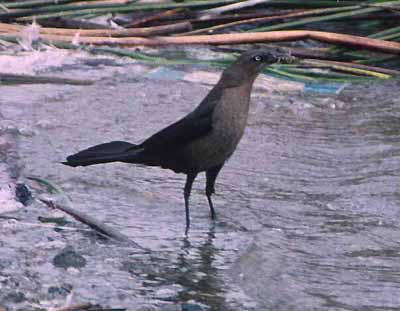 Not only does this female have whitish eyes (both of them do), but it is
both a much darker and a much browner bird than the Pt. Sur female. To
my eye, having seen both birds, the Roberts Lake bird is decidedly smaller
and somewhat short-tailed than the prior individual. She has a much reduced
supercilium, a brownish throat and malar, and more iridescent back, coverts,
and tail. The legs seem shorter and maybe thinner. It is a little hard
to compare bill shape & size, since in this photo the Roberts Lake
bird is carrying food for nestlings, but in the field it looks to me decidedly
smaller & slimmer than the Pt. Sur bird.
Not only does this female have whitish eyes (both of them do), but it is
both a much darker and a much browner bird than the Pt. Sur female. To
my eye, having seen both birds, the Roberts Lake bird is decidedly smaller
and somewhat short-tailed than the prior individual. She has a much reduced
supercilium, a brownish throat and malar, and more iridescent back, coverts,
and tail. The legs seem shorter and maybe thinner. It is a little hard
to compare bill shape & size, since in this photo the Roberts Lake
bird is carrying food for nestlings, but in the field it looks to me decidedly
smaller & slimmer than the Pt. Sur bird.
Below I place two more photos of these same individuals side by side:
1999 Roberts Lake female on the left, 1997 Pt. Sur bird on the right. I
don't know much about grackles, but to me these look like quite different
birds, and not just attributable to "variation" within a taxa. To me, these
"look" like two different taxa -- possibly different races (is there any
talk of different species?). Given that the nesting birds are decidedly
small, would it be appropriate to label them Q. m. nelsoni, and
the Pt. Sur individual something else, possibly Q. m. monsoni?
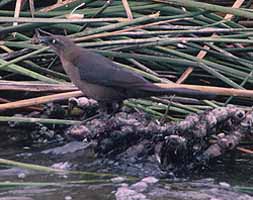

Peter Pyle's 1997 handbook for banders Identification Guide to North
American Birds, Part 1, highlights geographic variation in the
Great-tailed Grackle Quiscalus mexicanus. According to Pyle, the
two races are involved in the current invasion of California by Great-tailed
Grackles are nelsoni and monsoni. Pyle gives the range of
nelsoni
as "se. CA-s. NV to sw. AZ" and that of monsoni as "s.UT-s.CO to
sc. AZ-sw.TX." He also gives the nominate race mexicanus as having
the range "nc.MX, vag to s. TX" and the race prosopidicola as "s.NE
to s.TX-LA," noting that "four other subspecies" occur in Mexico-South
America.
Pyle states that the underparts of female nelsoni are "pale brown
with a buff wash" and that the iris is whitish to pale yellow. This is
certainly consistent with the nesting females, although the brown is somewhat
darker than "pale." Pyle says the underparts of female monsoni are
"brownish gray" and the iris whitish to pale yellow. There is no description
of underparts for any of the four races nesting in the United States as
being whitish or mottled grayish-white, the color of the Pt. Sur bird.
The measurements given show that female nelsoni is decidedly smaller
than female monsoni (or other races, for that matter): female wing-chord
124-140mm in nelsoni, 140-152mm in monsoni; female tails
117-134 in nelsoni, 141-165 in monsoni -- essentially no
overlap in the 10-12 individuals measured of each taxa. Pyle also characterizes
nelsoni
as a "small" race with "bill slender" while monsoni is a "medium
large" bird with "relatively long tail, bill moderately slender."
Phillips, Marshall & Monson (1964) Birds of Arizona gives a somewhat
different spin on the differences. They state that monsoni was the
first to invade Arizona from the east; it is the "large eastern race, minimum
tail length of first-year female 130mm)" and that the "adult female is
dark." It was breeding in Safford by 1936. The small race nelsoni
"with pale-colored females," invaded from the south, bred in Tucson in
1937-38 and again after 1940. There it met with monsoni and a mixed
population "now extends north to Phoenix." This mixing at Tucson has produced
"a population which seems to exceed in variability the combined norms for
both."
Below are two more photos of females; alas they were taken in the fall,
so are likely in fresher plumage than the May birds in Monterey County.
To the left is a female at Furnace Creek Ranch, Death Valley, Inyo Co.,
California (Nov 1987); to the right, just for fun, is a female on Cozumel
I., Mexico (Sep 1979). Possibly the Death Valley bird is monsoni
(see below; it is very brown below and looks substantially bigger than
the Monterey birds to me), but I am unable to find which race occurs on
Cozumel (presumably not one of the four in Pyle, since prosopidicola
only goes south to Tamaulipas per AOU 1957).
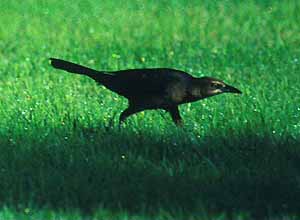

Great-tailed Grackles began invading California along the Colorado
River in 1964. Guy McCaskie collected four at Imperial Dam on 6 June 1964
(McCaskie, Stallcup & DeBenedictis, 1966, Condor 68: 595-597) which
have been identified as nelsoni by A. M. Rea (Unitt, 1984, The Birds
of San Diego County, San Diego Soc. Nat. Hist. Memoir 13). Rea, incidentally,
is also attributed (in Monson & Phillips, 1981, Annotated Checklist
of Birds of Arizona) with identifying the "mixed" race in south-central
Arizona, so presumably his reference of the Imperial Dam bird to nelsoni
excludes them being "mixed" race birds.
I don't know which race is supposed to be at Furnace Creek, but it is
a big race with a big bill, long tail, and very dark females. This fits
monsoni
or, at least, the "mixed" race which originates in Arizona. I had assumed
that it would be the same race as on the Colorado River, but maybe not.
In shape and size the Death Valley bird is like the Pt. Sur female,
but obviously it is much darker brown and has a buff supercilium. Perhaps
the Pt. Sur bird, being dark-eyed at one year of age and thus not in full
adult female plumage, just represents an immature female plumage?
Compared to the Furnace Creek birds, the Monterey nesting birds are
decidedly smaller, short-tailed, slimmer-billed, and paler and buffier
brown below. This fits the descriptions of nelsoni quite well. With
all due respect to Morlan's comments, why are not the Monterey nesters
nelsoni?
The other big difference is the prominent supercilium on the Death Valley
birds while the Monterey nesting birds almost lack an eyestripe. Could
this be an additional difference between the races?
As to males, there is paralleling variation. The top photo is of the
dominant male on his regular song/defense post at Roberts Lake, Monterey
County, taken 15 June 1999. He defended both territories in which the two
females nested, although two other males have been present off and on.
On this Monterey County male, please note the comparatively short bill
and short tail. The middle photo is a male at Furnace Creek Ranch, Death
Valley (Nov 1987). Eye color of the two birds looks the same to me, but
the Death Valley bird seems a bit longer-billed, decidedly longer-tailed
in the field, and seems to be mostly blue-glossed while the Monterey nesting
bird is more purple-glossed (but the males sound alike to me). Finally,
the bottom photo shows a male from the Rio Grande Valley of Texas (San
Ygnacio, March 1982). To me it is huge, with a big stout bill and a very
long tail, consistent with Pyle's description of the nominate race mexicanus
(rather than the coastal prosopidicola which is said to be relatively
short-tailed and slender-billed). Nominate mexicanus is stated to
be only a "vagrant to s. Texas," but maybe it is more regular than that?
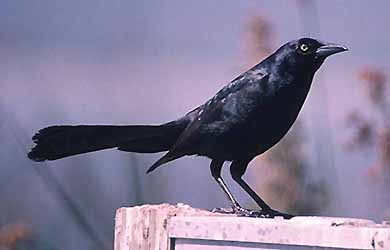
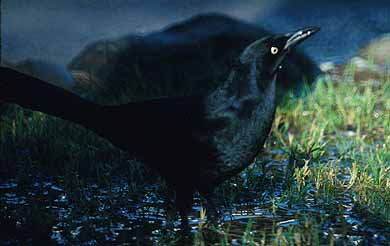
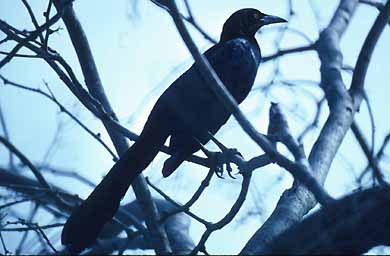
Some of these questions were addressed on "Frontiers" a year ago by
Al Jaramillo and follow-up posts. Jaramillo's final post on 31 May 1998
read: "Here is a response from Walter regarding my note on the Great-tailed
Grackles:
>Thanks for the post. Phil pointed out and our analysis
showed the situation
>to be more complicated than we initially believed. People may
be interested
>in the discussion section of our poster where we noted the following:
>
>"To determine the subspecific identities of California GTGR's we examined
>adult specimens (n=38), and, based upon wing chord and tail measurements,
>attempted to classify them as belonging to either nelsoni or monsoni.
Most
>specimens were collected in CA after 1987. Based upon these
measurements,
>of 17 adult females as many as 11 fall within the nelsoni parameter,
three
>are intermediate between the two, and one to three females' measurements
>place them within monsoni. Of 21 males, ten fall within nelsoni,
seven
>within monsoni, and four appear intermediate. We discerned no
temporal
>patterns to these data, although our sample size is admittedly small.
>
>The wing chord and tail measurements suggest that male GTGR show a
fairly
>even cline between nelsoni and monsoni characteristics. Classifying
females
>based upon coloration proved more problematic. Many CA specimens
have been
>collected during the spring and summer, when their plumage is worn
and
>faded. This made direct comparison of specimens impossible.
However, of
>the females collected after 1990, several showed coloration darker
than pure
>monsoni. We suspect female GTGR in California retain nelsoni
size
>characteristics and exhibit monsoni coloration.
>
>This is not the first species that has established a zone of secondary
>contact within CA. A similar situation has recently been studied
in the
>Brown-headed Cowbird (Fleischer and Rothstein 1988, Rothstein 1994).
Here,
>an invading subspecies (obscurus) has occupied CA's Central Valley
from the
>southeast within the last 100 years. Birds crossing the Sierra
Nevada near
>Mono Pass have presumably been breeding with the larger subspecies
>(artemisiae) to the east of the Sierran axis for about fifty years.
Their
>influence is now apparent in intermediate morphological characteristics
>(e.g. size, juvenile bill coloration) of birds within the contact
zone.
>
>The presence of grackles with intermediate morphological features
in CA
>indicates that a similar swamping of one subspecies by another within
a
>secondary contact zone may be occurring here. The data we colected
>suggested several intriguing possibilities, but the lack of specimens
>prevented us from drawing any firm conclusions. They did point
out that one
>cannot identify CA GTGR to subspecies by plumage characteristics alone.
>Plumage characteristics have to be combined with morphological measurements
>to accurately assign and individual to either subspecies. A
systematic
>collection of grackles is needed in CA, as suggested by Phillips (1950)
and
>undertaken by Rea (1969) in Arizona. Only then will it be possible
to
>answer the many questions raised by this ongoing invasion."
>Walter and Dan
Unfortunately, I'm not sure who "Water and Dan" are, but perhaps Al or
others will tell us.
So here's where I'm at so far:
-
Great-tailed Grackle shows much variation between races -- in color, size,
bill length & heft, and tail length -- that an observer familiar with
only one race could be confounded by another race.
-
Among the variations not covered well in the literature is the range of
underpart coloration in females, and the presence to almost absence of
a supercilium stripe which, when present, ranges in color from buff to
white.
-
There is the potential for field identification problems because the spectrum
of variation is not be well known. An observer used to Texas Great-tails,
for example, could conclude that a vagrant California Great-tails was something
else -- like a Common Grackle Q. quiscula -- and it is suspected
that several California claims of Common Grackle arise from this problem.
-
The Monterey County nesting birds, both the males and the females, being
decidedly small with short tails and slim, short bills, and the females
with quite brownish underparts, seem to match nelsoni well, but
others have been unable to assign California specimens to races.
-
Other Monterey County vagrants, like the Pt. Sur bird, do not match nelsoni
well and either illustrate the SUBSTANTIAL variation in nelsoni
in color, size, facial pattern, and bill size; or they represent another
taxa/race (including an intergrade of races?), quite possibily monsoni;
or
they represent a range of variation attributable to the swamping of races
in California.
Problems/questions/mysteries:
-
What are the Death Valley birds? Do we assume they are nelsoni because
the first Colorado River birds in 1964 were nelsoni?
-
If the Death Valley birds are nelsoni, why do the Monterey birds
look so much smaller, short-tailed and smaller-billed? Are the Death Valley
birds actually monsoni or a mixed race?
-
What was the Pt. Sur female and other similar vagrants? Does the Pt. Sur
bird represent monsoni in its usual first-summer female plumage?
-
Which races do reach California? What is their relative distribution and
status? And did they invade from different directions? For example, could
monsoni
and/or mixed birds have invaded the Mohave desert from the east and expanded
north to Death Valley, throwing off vagrants here and there, whilst the
smaller Sonoran nelsoni invaded up the Imperial Valley to the Central
Valley to Monterey?
-
How regular is nominate mexicanus in south Texas? and
-
Who cares, anyone? It's not like they are gulls.
I admit that I didn't pay much attention to the discussion a year ago about
variation and races of Great-tailed Grackle. Now it is a field problem
in my back yard. Although the final post a year ago suggests that only
specimens can provide answers (and certainly specimens would be useful),
I think we can review good photos to get at least a superficial handle
on the range of variation possible. What do you think? Comments welcome
at creagrus@montereybay.com.
All photos on this page are © Don Roberson; all rights reserved.
TOP
BACK TO
IDENTIFICATION PAGE
GO TO MONTEREY COUNTY
PAGE
BACK TO HOME PAGE
BACK TO LIST OF
BIRD FAMILIES OF THE WORLD
BACK TO BIRDING
THE WORLD PAGE
 At this very moment in late June 1999, the first Great-tailed Grackles
to nest in Monterey County (coastal central California) are feeding fledglings.
Yet the two females stuffing food down gaping throats look quite unlike
the female shown in the photo to the left. This female, an apparent first-summer
(SY="second calendar year" in banding lingo) Great-tailed Grackle, appeared
at Pt. Sur, Monterey County, on 29 May 1997. In fact, it was one of the
first females ever in Monterey County (the first male was in 1994). She
has already been featured
on Joe Morlan's web site with reference to the retained dark eyes at
this late date (nearly a year-old individual). More generally, Joe wrote
that the Great-tailed Grackle "exhibits a considerable amount of geographic
variation and is a relatively recent invader to California. Most California
birds are thought to be derived from the smaller Q. m. nelsoni,
but the larger Q. m. monsoni also apparently occurs. I suspect these
two forms probably intergrade here thus accounting for the high degree
of variability of California birds. I think subspecific identification
is unwise without measurements and examination in the hand."
At this very moment in late June 1999, the first Great-tailed Grackles
to nest in Monterey County (coastal central California) are feeding fledglings.
Yet the two females stuffing food down gaping throats look quite unlike
the female shown in the photo to the left. This female, an apparent first-summer
(SY="second calendar year" in banding lingo) Great-tailed Grackle, appeared
at Pt. Sur, Monterey County, on 29 May 1997. In fact, it was one of the
first females ever in Monterey County (the first male was in 1994). She
has already been featured
on Joe Morlan's web site with reference to the retained dark eyes at
this late date (nearly a year-old individual). More generally, Joe wrote
that the Great-tailed Grackle "exhibits a considerable amount of geographic
variation and is a relatively recent invader to California. Most California
birds are thought to be derived from the smaller Q. m. nelsoni,
but the larger Q. m. monsoni also apparently occurs. I suspect these
two forms probably intergrade here thus accounting for the high degree
of variability of California birds. I think subspecific identification
is unwise without measurements and examination in the hand."
 Not only does this female have whitish eyes (both of them do), but it is
both a much darker and a much browner bird than the Pt. Sur female. To
my eye, having seen both birds, the Roberts Lake bird is decidedly smaller
and somewhat short-tailed than the prior individual. She has a much reduced
supercilium, a brownish throat and malar, and more iridescent back, coverts,
and tail. The legs seem shorter and maybe thinner. It is a little hard
to compare bill shape & size, since in this photo the Roberts Lake
bird is carrying food for nestlings, but in the field it looks to me decidedly
smaller & slimmer than the Pt. Sur bird.
Not only does this female have whitish eyes (both of them do), but it is
both a much darker and a much browner bird than the Pt. Sur female. To
my eye, having seen both birds, the Roberts Lake bird is decidedly smaller
and somewhat short-tailed than the prior individual. She has a much reduced
supercilium, a brownish throat and malar, and more iridescent back, coverts,
and tail. The legs seem shorter and maybe thinner. It is a little hard
to compare bill shape & size, since in this photo the Roberts Lake
bird is carrying food for nestlings, but in the field it looks to me decidedly
smaller & slimmer than the Pt. Sur bird.






